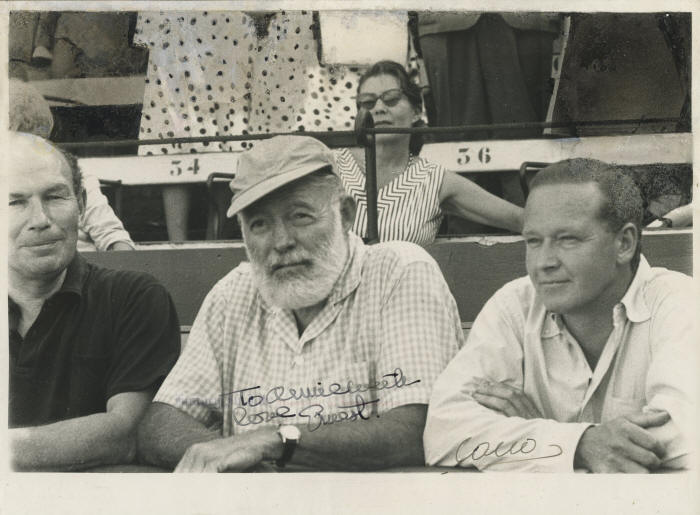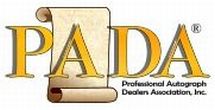2112301
Ernest Hemingway
Scroll down to see images of the item below the description
Hemingway signs a photo to one of his hosts
during his 1959 trip to Spain to gather new material on bullfights,
which led to his last published work before his death, Life magazine’s “The Dangerous Summer”
Ernest Miller Hemingway, 1899–1961. American novelist and writer; recipient of the 1953 Pulitzer Prize in Fiction and the1954 Nobel Prize in Literature. Vintage 7” x 9½” black-and-white casual portrait photograph inscribed and signed on the image, To Annie with / love Ernest. Also signed by the photographer, Cano.
This photograph, previously offered at Sotheby’s in London in 2012, shows the gray-bearded Hemingway in the stands at a bullfight in Spain during what he called “The Dangerous Summer” of 1959. He is sitting between his host, Bill Davis, on the left in the photo, and his physician, Dr. George Saviers, on the right. His hostess, Anne Davis, to whom he has inscribed and signed this photo, is behind him.
The photograph is an outstanding memento of Hemingway’s last trip to Spain, his last direct contact with bullfighting, about which he was passionate, and the last work he published before his death. Bullfighting figured prominently in his best-known works, The Sun Also Rises (1926), Death in the Afternoon (1932), and For Whom the Bell Tolls (1940). He wrote about it in his last work, Life magazine’s three-part series, “The Dangerous Summer,” which came out of this experience. A longer book version was posthumously published as The Dangerous Summer (1985).
Hemingway saw his first bullfight in 1923. In an article that autumn in the Toronto Star Weekly, he wrote that bullfighting, which he called “a survival of the days of the Roman Colosseum,” is “not a sport. It was never supposed to be. It is a tragedy. A very great tragedy. The tragedy is the death of the bull.” Yet Hemingway became a self-styled aficionado, and his interest in bullfighting bordered on obsession. It was, he wrote in Death in the Afternoon, “the only art in which the artist is in danger of death and in which the degree of brilliance in the performance is left to the fighter’s honor.”
Hemingway spent the summer of 1959 in Spain. Initially, he went to obtain fresh material to update Death in the Afternoon, his book about the ceremony and traditions of Spanish bullfighting that his publisher, Scribner’s, had decided to reissue. Hemingway thought that he could obtain enough new material from watching bullfights across the country to add an epilogue of several thousand words to it. He especially wanted to see a series of mano-a-mano bullfights that a promoter had organized between the leading Spanish matadors, Antonio Ordóñez and his brother-in-law, Luis Miguel Dominguin. Ordóñez’s father, Cayetano Ordóñez, had been the prototype for Pedro Romero, the matador character in The Sun Also Rises.
While in Spain, Hemingway stayed at La Cónsula, the Málaga estate of wealthy American expatriates Nathan William Davis—Bill to his friends—and his wife, Anne. A native of Indianapolis and a graduate of Yale University, Bill Davis and was a patron of the arts and the brother-in-law of British literary critic Cyril Connolly. Anne, from Baltimore, and was a distant relative of the ornithologist and painter John James Audubon. Together the Davises lavishly entertained celebrities and literary figures, including Noël Coward, Sir Laurence Olivier and his wife Vivien Leigh, and Orson Welles.
Hemingway had previously met Bill Davis in Mexico. In 1959, the Davises invited Hemingway and his fourth wife, Mary, to stay at their nineteenth century mansion, a large, white house with Doric columns and a view of the Mediterranean Sea, and gave the Hemingways the run of the house. The Hemingways arrived with 21 suitcases in tow. But what began as a working trip turned into an ongoing disaster for Hemingway, who drank heavily and showed signs of the mental disorder that ultimately caused his suicide in 1961.
Bill Davis personally chauffeured Hemingway to bullfights in cities all over Spain—among them Alicante, Aranjuez, Béjar, Bilbao, Ciudad Real, Cordoba, Cuencia, Madrid, Málaga, Mérida, Murcia, Pamplona, Ronda, Seville, and Valencia. Dr. Saviers and his wife joined Hemingway’s entourage at Pamplona.
The editors of Life learned that Hemingway was in Spain to gather material and asked him to write an article on bullfighting for Life before the larger version was to appear in book form. Hemingway agreed. Life wanted an article of 10,000 words, but Hemingway, disorganized, evidently suffering from depression, paranoia, and anxiety, drinking, and taking pills, could not stop writing. The article bedeviled him, continuing to grow until Hemingway had written more than 100,000 words. He asked for, but then rejected, and then accepted, help to cut the article. Even then, it was far too long. Ultimately Life bought a selection of the abridged version and published it in three installments as a 30,000-word series entitled “The Dangerous Summer” in September 1960. It was the last work that Hemingway published during his lifetime.
It was at La Cónsula that Mary Hemingway threw an elaborate party for Hemingway to celebrate his 60th birthday. She invited friends from around the world, had Chinese food flown in from London and champagne from Paris, brought in a small orchestra with Spanish guitarists to play while couples danced, and lit up the night with fireworks. Hemingway enjoyed the party, but he showed flashes of temper that exposed his mental disorder. The night before the party, he verbally assaulted his old friend from World War II, General Buck Latham, who had inadvertently brushed against his head as he passed behind him, and later apologized in tears. At the party, he ignored Mary in favor of the company of 19-year-old Valerie Danby-Smith, whom the Irish Times had sent to interview him, and whom he had then hired as his secretary.
Hemingway ignored Mary more and more as their time in Spain went by, all the while reveling in the attention of sycophants and flirting with other women. Mary eventually bored of the bullfights, returned to La Cónsula, and then returned to the United States while Hemingway stayed in Spain. She briefly separated from Hemingway, leaving their Ketchum, Idaho, summer home to move to New York while he was in Spain, but his telegram of apology convinced her to stay with him. They went to their winter home in Cuba, and then back to Idaho, where the troubled author’s psychological problems only became worse despite shock therapy treatments at the Mayo Clinic.
Hemingway committed suicide in Idaho on July 2, 1961. In his drawer, there were two tickets to the upcoming Pamplona bullfights.
From an unsigned photograph that we found of Hemingway wearing the same shirt and speaking at bullring level with matador Antonio Ordóñez, it appears that in this photo Hemingway, Bill Davis, and Dr. Saviers sat on the front row and were leaning on the wall surrounding the bullring. The relative potential for danger may explain why Anne Davis is in another row behind them.
The photographer who took this photograph, Paco Cano Lorenza (1912–2016), was a Spanish photojournalist from Valencia who specialized in photographing bullfighters. Luis Miguel Dominguin, one of the matadors whom Hemingway followed around Spain, was among Cano’s subjects.
Hemingway has signed this photograph in black fountain pen. The inscription and signature are crisp and clear. The photograph is mounted to a backing board and has been professionally restored in the upper background areas, not affecting either the image of Hemingway or his inscription and signature. Overall it is in very good to fine condition.
Auction results show that Hemingway’s signed photographs are significantly less available than are his signed books, checks, and even his correspondence. This photograph, with its direct association to Hemingway’s last work during his lifetime, would be an excellent addition to any Hemingway or American literature collection.
Unframed.
$4,350.00







